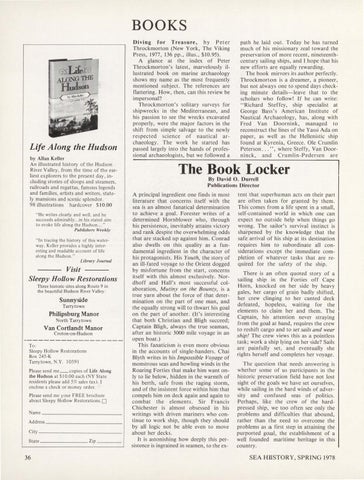BOOKS
Life Along the Hudson by Allan Keller An illustrated history of the Hudson River Valley, from the time of the earliest explorers to the present day , including stories of sloops and steamers, railroads and regattas, famous legends and famili es, artists and writers, stately mansions and sce nic splendor. 98 illustra ti ons hardcover SI 0.00 " He writes clearly and well, and he succeeds admirab ly.. .in his stat ed aim to evoke life along th e Hudso n.... " Publishers Weekly
" In tra cing th e history of this waterway, Keller provides a high ly interesting and readable account of life along th e Hudson." Library Journal
Visit Sleepy Hollow Restorations Three historic si tes along Route 9 in the beautiful Hudson River Valley:
Sunnyside Tarrytown
Philipsburg Manor North Tarrytown
Van Cortlandt Manor Croton-on-Hudson To: Sleepy Hollow Res tora tions Box 245-K
Tarrytown , .Y. 10591 Please send me_ copies of Life Along the Hudson at $10.00 each (N Y State residents please add 5% sales tax). I enclose a check or money order. Please send me your FREE brochure about Sleepy Hollow Rest ora ti ons. O
Address----- -- - - - - - City _ _ _ _ _ _ _ _ _ _ _ _ __ State _ _ _ _ _ _ _ _ Zip _ _ __
36
Diving for Treasure, by Peter Throckmorton (New York, The Viking Press, 1977, 136 pp., illus., $10.95). A glance at the index of Peter Throckmorton's latest, marvelously illustrated book on marine archaeology shows my name as the most frequently mentioned subject. The references are flattering. How, then, can this review be impersonal? Throckmorton's solitary surveys for shipwreck s in the Mediterranean, and his passion to see the wrecks excavated properly, were the major factors in the shift from simple salvage to the newly res pected science of nautical archaeology. The work he started has passed largely into the hands of professional archaeologists, but we followed a
path he laid out. Today he has turned much of his missionary zeal toward the preservation of more recent, nineteenthcentury sai ling ships, and I hope that his new efforts are equally rewarding. The book mirrors its author perfectly. Throckmorton is a dreamer, a pioneer, but not always one to spend days checking minute details-leave that to the scholars who follow! If he can write: "Richard Steffey, ship specialist at George Bass's American Institute of Nautical Archaeology, has, along with Fred Van Doornink, managed to reconst ruct the lines of the Yassi Ada on paper, as well as the Hellenistic ship found at Kyrenia, Greece. Ole Crumlin Peterson .. . ", where Steffy, Van Doorninck, and Crumlin-Pedersen are
The Book Locker By David 0. Durrell Publications Director
A principal ingredient one finds in most literature that concerns itself with the sea is an almost fanatical determination to achieve a goal. Forester writes of a determined Hornblower who, through his persistence, inevitably attains victory and rank despite the overwhelming odds that are stacked up against him . Conrad also dwells on this quality as a fundamental ingredient in the character of his protagonists. His Youth, the story of an ill-fated voyage to the Orient dogged by misfortune from the start, concerns itself with this almost exclusively. Nordhoff and Hall 's most successful colaboration, Mutiny on the Bounty, is a true yarn about the force of that determination on the part of one man, and the equally strong wi ll to thwart his goal on the part of another. (It's interesting that both Christian and Bligh succeed; Captain Bligh, always the true seaman, after an historic 3000 mile voyage in an open boat.) This fanaticism is even more obvious in the accounts of single-handers. Chai Blyth writes in his Impossible Voyage of monstrous seas and howling winds in the Roaring Forties that make him want only to lie below, hidden in the warmth of his berth, safe from the raging storm, and of the insistent force within him that compels him on deck again and again to combat the elements. Sir Francis Chichester is almost obsessed in his writings with driven mariners who continue to work sh ip, though they should by all logic not be able even to move about her decks. It is astonishing how deeply this persistence is ingrained in seamen, to the ex-
tent that superhuman acts on their part are often taken for granted by them. This comes from a life spent in a small, self-contained world in which one can expect no outside help when things go wrong. The sailor's survival instinct is sharpened by the knowledge that the safe arrival of his ship at its destination requires him to subordinate all considerations except the immediate completion of whatever tasks that are required for the safety of the ship. There is an often quoted story of a sailing ship in the Forties off Cape Horn, knocked on her side by heavy gales, her cargo of grain badly shifted, her crew clinging to her canted deck defeated, hopeless, waiting for the elements to claim her and them. The Captain, his attention never straying from the goal at hand, requires the crew to reshift cargo and to set sails and wear ship! The crew views this as a pointless task; work a ship lying on her side? Sails are painfully set, and eventuall y she rights herself and completes her voyage. The question that needs answering is whether so me of us participants in the historic preservation field have not lost sight of the goals we have set ourselves, while sailing in the hard winds of adversity and confused seas of politics . Perhaps, like the crew of the hardpressed ship, we too often see only the problems and difficulties that abound, rather than the need to overcome the problems as at first step in attaining the purported go.al, the establishment of a well founded maritime heritage in this country.
SEA HIISTORY, SPRING 1978
